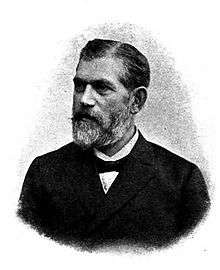Julius Hirschberg

Julius Hirschberg (1843-1925)
Julius Hirschberg (18 September 1843 – 17 February 1925) was a German ophthalmologist and medical historian.
In 1875, Hirschberg coined the term "campimetry" for the measurement of the visual field on a flat surface (tangent screen test) [1] and in 1879 he became the first to use an electromagnet to remove metallic foreign bodies from the eye.[2] In 1886, he developed the Hirschberg test for measuring strabismus.[2] His series Geschichte der Augenheilkunde (History of Ophthalmology), nine volumes written from 1899 to 1917, is considered by some to be one of his greatest achievements.[3]
Notes
- ↑ The age of isopter perimetry at webeye.ophth.uiowa.edu
- 1 2 Manage Account - Modern Medicine at www.ophthalmologytimes.com
- ↑ (Julius Hirschberg (1843-1925), ophthalmologist an...(Klin Monatsbl Augenheilkd. 1976) - PubMed Result at www.ncbi.nlm.nih.gov
External links
Pubmed
- Snyder C. "Julius Hirschberg, the neglected historian of ophthalmology." Am J Ophthalmol. 1981 May;91(5):664-76. PMID 7015867 .
- Biro I. "[In memory of Julius Hirschberg.]" Orv Hetil. 1976 Aug 8;117(32):1953-4. PMID 785335.
- Koelbing HM. "[Julius Hirschberg (1843-1925), ophthalmologist and medical historian (author's transl).]" Klin Monatsbl Augenheilkd. 1976 Jan;168(1):103-8. PMID 789990.
This article is issued from Wikipedia - version of the 3/1/2016. The text is available under the Creative Commons Attribution/Share Alike but additional terms may apply for the media files.
